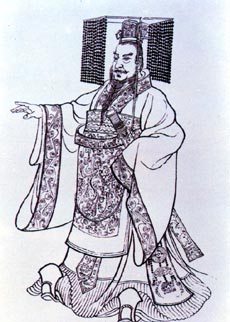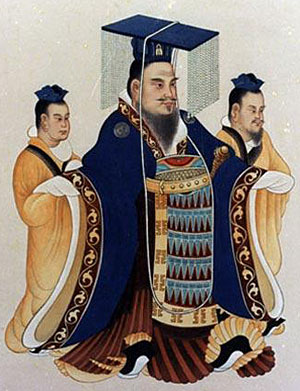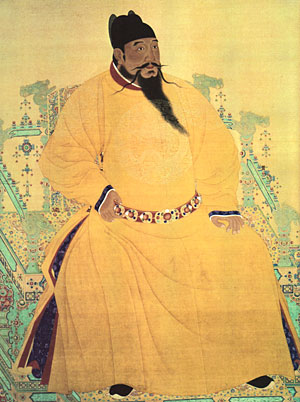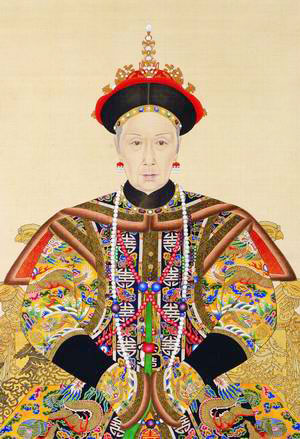

One World
Nations Online
All Countries in the World
 |
 One World Nations Online All Countries in the World |
| Home see also: |
|||
___ Chinese DynastiesTimeline of Chinese Imperial and Modern Dynasties. |
|||
| ANCIENT CHINA Chinese civilization, as described in mythology, begins with Pangu, the creator of the universe, and a succession of the legendary sage-emperors Yao and Shun and other culture heroes who taught the ancient Chinese to communicate and to find livelihood, clothing, and shelter. |
|||
| 3 Sovereigns and 5 Emperors (Chinese: 三皇五帝; pinyin: Sān huáng wǔ dì) The Wŭ dì jì or Mythic Period of the Five Emperors, the mythological rulers of China during the time preceding the Xia Dynasty. The Three Sovereigns were said to be god-kings or demigods who used their magical powers to improve the lives of their people. The Three Sovereigns are ascribed various identities in different Chinese historical texts. The "Records of the Grand Historian" by Sima Qian, in a chapter added by Sima Zhen, states that they were: The Heavenly Sovereign (天皇; tiānhuáng: Son of Heaven) The Earthly Sovereign (地皇; dìhuáng: Earth Emperor) The Human Sovereign (泰皇 or 人皇; tàihuáng: Peaceful Emperor) The Chunqiu yundou shu (春秋運斗樞) and Chunqiu yuanming bao (春秋元命苞) identify them as: Fuxi (伏羲) |
ca. 2852 - 2205 BC |
||
| Xia Dynasty (Hsia Dynasty) (夏朝; Xià cháo). Early Chinese dynasty, mentioned in legends but of undetermined historicity, despite historical records such as 'Records of the Grand Historian' and the 'Bamboo Annals'. According to these records, the founder and first ruler was Yu the Great (Yǔ, 禹). |
2100 - 1600 BC | ||
| Shang Dynasty (商朝; Shāng cháo) or the Yin Era (殷代, Yīn dài) First recorded Chinese dynasty for which there is both documentary and archaeological evidence. The latter part of the Shang dynasty, from the reign of P'an-k'ang on, is also called the Yin dynasty. It was in the Shang period that Chinese writing began to develop. |
The dates for the dynasty vary, traditionally 1766 - 1122 BC Map of Shang Dynasty |
||
| Zhou Dynasty (Chou dynasty) (Chinese: 周朝; pinyin: Zhōu cháo), The Zhou ruled ancient China for almost a millennium, establishing the distinctive political and cultural characteristics that were to be identified with China for the next 2,000 years. The Zhou coexisted with the Shang for many years, living just west of the Shang territory in what is now Shaanxi province. In mid-11th century the Zhou solidified their reign over all of China. An array of feudal states was created within the empire to maintain order and the emperor's hold on the land. |
The latest [proposed] date for the beginning of the Zhou dynasty is 1027 BC traditionally 1122 - 256 BC Map of Zhou Dynasty |
||
| The period before 771 BC is usually known as the Western Zhou dynasty (Chinese: 西周, pinyin: Xī zhōu). |
ca. 1122/1027 - 771 BC | ||
| The period from 770 is known as the Eastern Zhou (Chinese: 東周; pinyin: Dōng zhōu). The Eastern Zhou is often further subdivided into the Spring and Autumn Period ( 春秋時代; pinyin: Chūn qiū shí dài), when China consisted of many small squabbling states, and the Warring States Period ( 戰國時代; pinyin: Zhàn guó shí dài), when the small states consolidated into several larger units, which struggled with one another for mastery The Seven Warring States formed from the weakening of the Zhou Dynasty. They were: Chu (楚), Han (韓/韩), Qi (齊/齐), Qin (秦), Wei (魏), Yan (燕) and Zhao (趙/赵). Finally, one of these small kingdoms, Qin (Ch'in from which derives modern China's name), succeeded in conquering the rest of the other states and established the Qin dynasty. |
770 - 256 BC ca. 722 - 481 BC ca. 403 - 256/ 221 BC |
||
| IMPERIAL CHINA | |||
 Flag of Imperial China Qin Dynasty (Chinese: 秦朝; pinyin: Qín cháo) also known as the Ch'in dynasty, established the first great Chinese empire. The Ch'in (Qin), from which the name China is derived, established the approximate boundaries and the basic administrative system that all subsequent Chinese dynasties were to follow for the next 2,000 years. They also standardized the writing system, standardized the measurements of length and weight and the width of highways/roads and they built the precursor version of the Great Wall. But under its Emperor Qin Shi Huang and his chief adviser Li Si, the Qin also instituted a rigid, authoritarian government based on the principles of the Legalists: human beings were fundamentally base and selfish and had to be strictly controlled through laws. The Qin abolished all feudal privileges, and in 213, to halt subversive thought, they ordered all books burned. |
221 BC - 207 BC |  Emperor Qin Shi Huang (秦始皇; Qín Shǐhuáng; 259 BC – September 10, 210 BC) became the first emperor of a unified China in 221 BCE. |
|
| Han Dynasty (Chinese: 漢朝; pinyin: Hàn cháo) is the second great Chinese Imperial dynasty, considered to be the prototype for all later Chinese dynasties. The dynasty was founded by Liu Bang, the later Emperor Gaozu of Han (高祖; Gāozǔ), a man of humble birth who led the revolt against the repressive policies of the preceding short-lived Qin dynasty. The Han adapted the highly centralized Qin administrative structure, a country divided into a series of administrative areas ruled by centrally appointed officials. The Han adopted a Confucian ideology that emphasized moderation and virtue and thereby masked the authoritarian policies of the ruling. Most famous Emperor of the Han dynasty was Emperor Wu of Han (漢武帝; hànwǔdì), (156 BC – March 29, 87 BC), personal name Liu Che (劉徹), he was the seventh emperor of the Han Dynasty, ruling from 141 BC to 87 BC. Under his reign China experienced a vast territorial expansion. |
206 BC - 220 AD Map of the Han Dynasty |  Emperor Wu of Han |
|
| The period of the Han Dynasty, before Wang Mang's usurpation (Xin Dynasty), when the Han capital was in the western Chinese city of Ch'ang-an, is called the
Former Han Dynasty (前漢; Qián hàn) or the Western Han Dynasty (西漢; xī hàn). |
206 BC - 25 AD |
||
| Xin Dynasty (or Hsin, 新朝; Xīn cháo), short-lived dynasty in China formed by Wang Mang (王莽; wáng măng), a Han Dynasty official who seized the throne from the Liu family. Wang Mang, with his sucessor Liu Keng-shih, ruled during an interim between the Former Han and Later Han dynastic periods. |
09 AD - 25 AD | ||
| The period after Wang Mang's Xin Dynasty is called the Eastern or Later Han Dynasty (Chinese: 東漢; Dōng hàn). Emperor Guangwu (光武帝) reinstated the Han Dynasty with the support of land-holding and merchant families at Luoyang, east of Xi'an. Han power declined again amidst land acquisitions, invasions, and feuding between consort clans and eunuchs. The Yellow Turban Rebellion (黃巾之亂,黄巾之乱) broke out in 184, ushering in an era of warlords. |
25 - 220 AD Map of Eastern Han Dynasty |
||
| Three Kingdoms period and the Six Dynasties | |||
| Three Kingdoms (三國; Sān guó) a period in the history of China called the Six Dynasties. An era of disunity, when three kingdoms Wei, Shu, and Wu were competing for control of China. As a result of the disintegration of the society, constant foreign incursions, and alien reign throughout the North, many fundamental changes occurred in China during this period. The Confucian system that had ordered society was in ruins, and the growing influence of Taoism and the importation of Buddhism worked profound changes everywhere. The period of the Three Kingdoms followed immediately after the loss of the de facto power of the Han Dynasty emperors and the foundation of the Sui Dynasty. |
220 - 280 AD | The three kingdoms were Wèi (魏), Shǔ (蜀), and Wú (吳). This time period has been greatly romanticized in works such as the 'Romance of the Three Kingdoms'. |
|
| Cao Wei (曹魏; Cáo wèi) also known as Ts'ao Wei (Wade Gilles), was one of the empires that competed for control over China during the Three Kingdoms period. The empire was established by Cao Pi with its capital at Luoyang in (today's) Henan province. |
220 - 265 AD | Six Dynasties (Chinese: 六朝; Pinyin: Liù Cháo) the term denotes the six Chinese dynasties during the periods of the Three Kingdoms, the Jin Dynasty, and Southern and Northern Dynasties. The six dynasties were: |
|
| Shu Han (蜀漢; Shǔ hàn) The kingdom was based on areas around Sichuan which was then known as Shu. |
221 - 263 AD | ||
| Wu/ Eastern Wu (東吳; Dōng wú) A historical independent state in the Jiangnan (Yangtze Delta) region, in southern and southeastern China. |
222 - 280 AD | ||
| Jin Dynasty (晋朝; Jìn cháo) also called Chin Dynasty, comprises two distinct phases — the Western Chin, and the Eastern Chin. The dynasty was founded by the Sima (司馬, sīmǎ) family. |
265 - 420 AD | ||
| Western Jin (Chinese: 西晉; pinyin: Xī jìn) was founded by Emperor Wu of Jin (晉武帝, jìn wǔ dì), better known under his personal name Sima Yan. After Wu had forced Cao Huan, the last of the Cao emperors, to abdicate to him, Wu established the dynasty. He reigned from 265 to 290 AD, and after he had destroyed Eastern Wu in 280 AD he was the emperor of the unified Chinese empire. |
265 - 316 AD | ||
| Eastern Jin (Chinese: 東晉; pinyin: Dōng jìn) supported by prominent local families of Zhu, Gan, Lu, Gu and Zhou, a prince of the Sima family, Prince of Langye the later Emperor Yuan of Jin, established a court in Jiankang, near todays Nanjing (Nanking, Jiangsu Province) in 317 AD, and this dynasty became known as the Eastern Jin, one of the so-called Six Dynasties. |
317 - 420 AD Map of Eastern Jin Dynasty |
The Sixteen Kingdoms (十六國; Shí liù guó) 304 - 439 AD are numerous short-lived kingdoms in Inner China and its neighboring areas, after the retreat of the Jin Dynasty to South China. Almost all rulers of the kingdoms were of Wu Hu ethnicity, people from the non-Chinese steppe tribes. |
|
| Southern & Northern Dynasties (Chinese: 南北朝; pinyin: Nán běi cháo) With the collapse of Eastern Jin in 420 AD, China entered the era of the Southern and Northern Dynasties. In north the Northern Wei Dynasty (386–534 AD) of the Xianbei tribe dominated the northern part of China, south of Yangtze River the Chinese dynasty Liu Song (劉宋) ruled the land. Like most of the time in China's history, it was again an age of civil war and political disunity. Despite of this troubles it was also a time of flourishing of arts and culture, advancement in technology. Buddhism, imported from India, and the native religion and philosophy of Taoism were spreading. |
420 - 589 AD Map of Southern & Northern Dynasties | Bookmark/share this page
|
|
| Sui Dynasty (Chinese: 隋朝; pinyin: Suí cháo) The short-lived dynasty, founded by Emperor Wen (Yang Jian), unified Southern and Northern China after four centuries of fragmentation in which North and South had gone quite different ways. It was a period of great prosperity. |
581 - 618 AD Map of Sui Dynasty |
||
| Tang Dynasty (Chinese: 唐朝; pinyin: Táng cháo) founded by the Li (李) family, who seized power during the decline and collapse of the Sui Empire. The capital of the dynasty was Chang'an (present-day Xi'an), the most populous city in the world at that time. The Tang period is regarded by historians as a high point in Chinese civilization - equal to or surpassing that of the earlier Han Dynasty - as well as a golden age of cosmopolitan culture. Its territory, acquired through the military campaigns of its early rulers, was greater than that of the Han period, and rivaled that of the later Yuan Dynasty and Qing Dynasty. The Tang Dynasty was largely a period of progress and stability, except during the An Shi Rebellion and the decline of the central authority in the latter half of the dynasty. | 618 - 907 AD Map of Tang Dynasty |
||
| Second Zhou Wang xuan (王璿) The Tang dynasty was interrupted briefly by the Second Zhou Dynasty when Empress Wu Zetian (武則天; Wǔ Zétiān) seized the throne, becoming the first and only Chinese empress regnant, ruling in her own right. Wu began her career at the age of 13 as a junior concubine at the palace of the second Tang emperor Taizong. |
October 16, 690 - March 3, 705 AD | ||
| Five Dynasties and Ten Kingdoms (Chinese: 五代十國; pinyin: Wǔ dài shí guó) The period was an era of political upheaval in China, beginning in the Tang Dynasty and ending in the Song Dynasty. This period lasted a little more than half a century, and China was scattered in a multi-state nation. Five dynasties quickly succeeded one another in the old Imperial heartland in northern China, and more than 12 independent states were established, mainly in parts of southern and western China. However, only ten are traditionally listed, hence the era's name "Ten Kingdoms". |
907 - 960 AD | Liao Dynasty (Chinese: 遼朝; pinyin: Liáo cháo), also known as the Khitan Empire (契丹國), was an empire in northern China that ruled over the regions of Manchuria, Mongolia, and parts of northern China proper. The empire was founded by Liao's first ruler Emperor Taizu of Liao (Yelü Abaoji) of the Yelu clan (耶律 Yēlǜ), in the same year as the Tang Dynasty collapsed. |
907 - 1125 AD |
| The Five Dynasties of Northern China: Later Liang Dynasty; 907 – 923 AD Later Tang Dynasty; 923 – 936 AD Later Jin Dynasty; 936 – 947 AD Later Han Dynasty; 947 – 951 AD Later Zhou Dynasty; 951 – 960 AD Ten Kingdoms: Wu; (吳國; Wú) 907 – 937 AD Wuyue (吳越國; Wúyuè guó) 907 – 978 AD Min (閩; Mǐn) 909 – 945 AD Chu (楚; Chǔ) 907 – 960 Southern Han (南漢; Nán hàn) 917 – 971 Foundation of the State of Shu under Tang rule in 903 Former Shu (前蜀, Qián Shú) 907 – 925; Later Shu (後蜀; Hòu Shú) 934 – 965 Jingnan (荆南; Jīng Nán) 924 – 963 Southern Tang (南唐; Nán Táng) 937 – 975 Northern Han (北漢; Běi Hàn) 951 – 979 |
|||
Song Dynasty |
960 - 1279 AD |
||
| Northern Song (Chinese: 北宋; pinyin: Běi sòng) Emperor Taizu of Song (r. 960–976) unified China through military conquest during his reign, ending the upheaval of the Five Dynasties and Ten Kingdoms Period. With a strong central government the dynasty controlled most of inner China. The Song capital was in the northern city of Bianjing (today Kaifeng, eastern Henan province). |
960 - 1127 AD | Western Xia Dynasty (Chinese: 西夏; pinyin: Xī Xià) The Empire was established by Tangut tribes and existed almost 200 years in what are now the northwestern Chinese provinces of Gansu, Shaanxi, and Ningxia. |
1038 - 1227 AD |
the Liao Dynasty and the Western Xia Dynasty 1000 AD |
|||
| Southern Song (Chinese: 南宋; pinyin: Nán sòng) refers to the period after the Song lost control of northern China to the Jin Dynasty. The Song court retreated and established its capital at Lin'an located in the Yangtze River Delta (today Hangzhou, Zhejiang province). Although weakened and pushed south along the Huai River, the Southern Song found new ways to bolster their already strong economy and to defend their state against the Jin Dynasty. The government sponsored massive shipbuilding and harbor improvement projects, to protect and support the multitudes of ships sailing for maritime interests. With this the Song Dynasty established China's first permanent navy in 1132. |
1127 (1131) - 1279 AD |
Jin Dynasty (Chinese: 金朝; pinyin: Jīn cháo) The Jin Dynasty (also called Gold Dynasty) was founded by a nomadic Manchu tribe known as the Jurchens (女眞; nǚzhēn) who originated from the Manchuria region. In 1115, one of the Jurchen leaders, Wanyan Aguda, unified the whole Jurchen group and established the Jin Dynasty in Huining Fu (today Acheng, Heilongjiang Province). Later, the capital city was moved to Yanjing (today Beijing) and finally settled in Bianjing (currently Kaifeng, eastern Henan province). |
1115 - 1234 AD |
and the Jin Dynasty 1200 AD |
|||
| The Yuan Dynasty (Chinese: 元朝; pinyin: Yuán cháo) The dynasty's official title 'Da Yuan' (Chinese: 大元, "Great Yuan") originates from 'I Ching'. It was the first non-Han dynasty to rule all of China. It was a khanate of the Mongol Empire, a political entity ruled by a Khan, namely Kublai Khan (Chinese: 忽必烈; pinyin: Hū bì liè). He became the first Yuan emperor, his reign dominated over Mongolia, Inner China, and some adjacent areas. Kublai Khan proclaimed the capital to be at Dadu (today Beijing). After some years of hard work, he finally defeated the Han-Dynasty of Southern Song in 1279. As emperor he also worked hard to minimize the influences of regional lords who had held immense power before and during the Song Dynasty. Almost all important central posts were monopolized now by Mongols. Unlike his predecessors Kublai Khan had decided to become the first absolute monarch. |
1271 - 1368 AD |
||
| Ming Dynasty (Chinese: 明朝; pinyin: Míng cháo) The Empire of the Great Ming followed the collapse of the Mongol Yuan Dynasty. Rivalry among the Mongol imperial heirs, natural disasters, and uprisings of Han Chinese groups against the Yuan Dynasty led to its collapse. The Ming dynasty was founded by the Han Chinese Zhu Yuanzhang, a former Buddhist monk from a peasant family. In 1356 Zhu Yuanzhang's rebel force captured the city of Yingtian (Nanjing), where he established his own military base. In 1368, after Zhu Yuanzhang's army captured the Yuan capital Dadu (today Beijing), Zhu Yuanzhang officially proclaimed himself Emperor of China and founded the Ming Dynasty. Under Zhu Yuanzhang the Chinese government established a standing army of 1,000,000 warriors and ordered the construction of a vast navy. The era saw enormous projects of construction, including the restoration of the Grand Canal, the Great Wall and the construction of the Imperial Palace (Forbidden City) in Beijing. The Ming was the last imperial dynasty in China ruled by ethnic Hans. |
1368 - 1644 AD |  Yongle Emperor (永樂; Yǒnglè); May 2, 1360 – August 12, 1424), third emperor of the Ming Dynasty of China from 1402 to 1424. |
|
| Qing Dynasty (Chinese: 清朝; pinyin: Qīng cháo) The Great Qing (also called the Later Jin) was the last ruling dynasty of China. The dynasty was founded by Manchus (Jurchen tribes), who are today an ethnic minority in northeast China. By 1646 the Manchus ruled over most of present-day China. The dynasty was founded by Nurhaci (Chin.: 努尔哈赤 pinyin: Nǔ ěr hā chì) a former vassal of the Ming emperors. In 1616 he proclaimed himself Khan of "Great Jin", after he had consolidated the Jianzhou region to unify the Jianzhou Jurchen tribes. Two years later Nurhaci openly renounced the sovereignty of Ming overlordship. Under his command he united the loosely joined Jurchen tribes into a nation. He also confederated with various Mongol tribes. After Nurhaci's dead his son Hung Taiji (皇太極) continued to fight the Ming dynysty. He laid the groundwork for the conquering of the Ming in China, although he died before this was accomplished. In June 1644 the Manchus seized control of Beijing and proclaimed the Qing dynasty to be the legitimate successor to the Ming Dynasty. Its first emperor Shunzhi Emperor was the second emperor of the Manchu Qing dynasty, and the first Qing emperor to rule all over China from 1644 to 1661. In the course of time under Emperor Kangxi, the Qing dynasty defeated Taiwan and Tzarist Russia. The dynasty lasted until 1911 after its decline in the mid-19th century. Following the Xinhai Revolution the Qing Dynasty was overthrown. |
1644 - 1911 AD |  Empress Dowager Cixi (Chinese: 慈禧太后; pinyin: Cíxǐ Tàihòu) de facto ruler of the Manchu Qing Dynasty, ruling over China for 48 years from her husband's death in 1861 to her own death in 1908. |
|
| MODERN CHINA | |||
| Republic of China | 1912 - 1949 AD | ||
| People's Republic of China | 1949 - present | Republic of China on Taiwan/ Taiwan Post War Era 1945 - present) | |
| The Mao Era | 1949-1976 AD | ||
| Era of Reconstruction | 1976-1989 AD | ||
| A Rising Power | 1989-2002 AD | ||
| China Today | 2002-present | ||
| Sources: Encyclopaedia Britannica, Wikipedia and others |
|||
| Country information: China | Bhutan | Hong Kong | India | Japan | Korea | Mongolia | Taiwan | Thailand | Vietnam More about China: Landmarks: Cities - City description with a searchable map and satellite view of: Chongqing, Guangzhou, Shanghai, Tianjin, Lhasa (Tibet), Hong Kong (SAR), Macau (SAR) Country: China key statistical data. Continent: Back to the index of Chinese Customs and Traditions Glossary |
|||
One World - Nations Online .:. let's care for this planet To the mind that is still, the whole universe surrenders. 老子 |
| Site Map | Information Sources | Advertise with OWNO | Disclaimer: Privacy Policy, etc. | Contact: [email protected] | Copyright © 1998-2016 :: nationsonline.org |